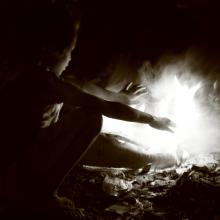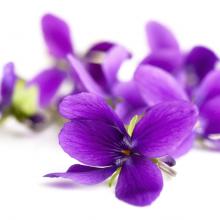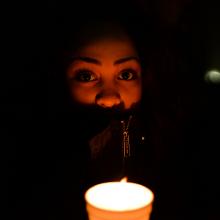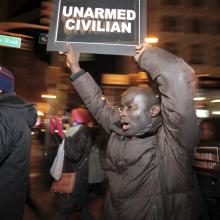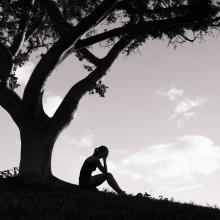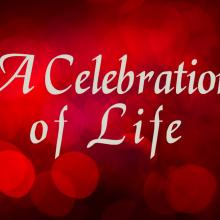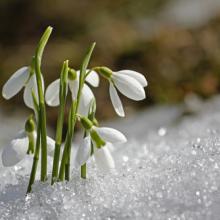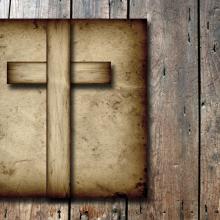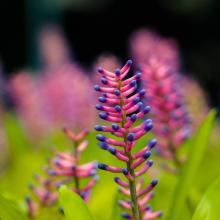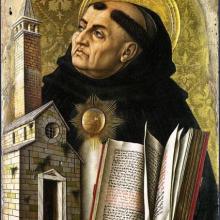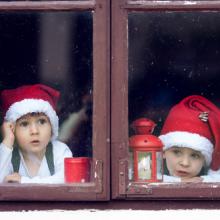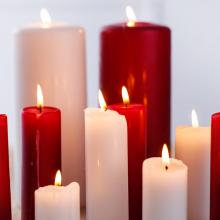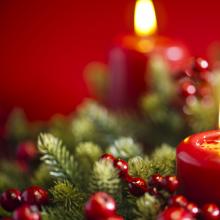Advent
Hope is not a feeling. It is a decision — a choice you make based on what we call faith or moral conscience, whatever most deeply motivates you.
I have said that for many years, but this Advent and Christmas season tests my words — even in my own heart.
This is not a time that many of us are feeling a great deal of hope. I hear that from many friends and allies as well.
In fact, many events this year feel like they have sucked the hope right out of us.
And yet, even in the midst of terrible events and stories, the possibilities of hope still exist depending on what we decide to do for reasons of faith and conscience. In fact, people of faith and conscience are already making a difference in the most difficult situations and places.
And that gives me hope. This season of Advent, in the Christian tradition, is a call to patient waiting.
Christmas is the celebration of God literally coming into the world in order to change it.
What can local churches do to support ongoing protests against, and indeed upheaval of, an unjust criminal justice system and deep-seated white supremacy? In a season that Lisa Sharon Harper recently described as “Advent as protest,” what might it mean for Christians to anticipate the coming of Christ by physically challenging oppression? For pastors all over the United States, these are the questions of the moment.
In Washington, D.C., local faith communities sought to live into the vision of Advent as protest by holding a “vigil for justice.” Although this vigil beautifully documented the capacity of the local church to advocate for justice, the way local media framed the vigil forces communities of faith to think more deeply about their understanding of solidarity.
Spread out along nearly 6.5 miles of 16th Street, hundreds of people held candles and signs in support of recent protests against racial injustice. As people passionately waved their signs or held their heads down in prayerful lament, passing cars and buses slowed to honk in support. Catching on with the theme of Advent, attendees hoped to shine light in the darkness not only to create awareness and show solidarity, but also to testify to the hope of faith.
Cecilia Choi, a member of District Church explained, “This is the time of Advent when God came and he started his work of reconciliation with us by becoming one of us. And I think it’s perfect to come out and work on reconciliation and joining with our black brothers and sisters. They’re not just our neighbors, they’re our brothers and sisters in Christ. We have such an obligation to them. I think this is an act of worship.”
When asked why she was on the streets, one woman responded, “Well, what do I say? [Laughs.] That’s the meaning of our faith! To be one with people who are suffering.” Another man called racism “the deepest sin in the United States.”
Such descriptions of the vigil reach to the core of the church’s mission to “do justice, love mercy, and walk humbly.” Here are churches standing in solidarity with those suffering at the hands of racist oppression as an “act of worship.” Here are churches bringing their resources of prayer, lament, and peace into the public sphere, challenging observers to wrestle with God’s call to justice. Yet, though the event was beautiful, the way it was framed by local media raises tough questions for churches. Contrasting this demonstration with other recent protests, one reporter said, “This protest was in contrast to many of the protests we’ve seen over the past few weeks, with groups blocking traffic and loudly chanting. This group was quiet and purposeful.”
Author's Note: As we close out Advent, when we so quickly determine what’s our legal right or what we’re owed or what “the Bible really says” when, after all, we’re just simply too quick to judge. In these days where we must affirm #BlackLivesMatter, where we must stand up for victims of rape and abuse, and where we must struggle with our LGBTQ sisters and brothers for full inclusion, sermons like this are humbly offered.
We know the Christmas story well.
Those of us that have grown up with regular, annual, church-going rhythms — we essentially hear this story once a year.
Even so, those with no regular church commitments — people from all walks of life, people of faith or no particular faith, people from varied faiths — if you asked your friend, your neighbor, your cousin, a stranger on the street, I bet at least 50 percent of the time they’d be able to share the gist of the story:
Jesus was born to a virgin named Mary.
Mary was married to a guy (named Joseph).
There were angels, and wise men, and shepherds.
And I think there was a manger.
We know this story well.
But we hear it so often it becomes rote — literally a mechanically, automatically, mindlessly routine on repetition in our brains.
Yeah, yeah, yeah — 6lb 8oz baby Jesus, in a manger, Virgin Mary, Adopted Dad Joseph, sheep, shepherds, angels, stars at night, wise men, white Christmas, Rudolph the Red Nosed Reindeer …
You get my point.
So, let’s hear the story one more time and lean in a bit to this wild world of dreams, angels, and ancient Jewish marriage contracts.
On a Sunday when the dominant color in Christian churches is pink — a symbol of joy for the third Sunday of Advent — I was wearing a black shirt, black pants, and a blue tie. Others in our congregation were wearing various combinations of black or blue.
This was a modest way of showing solidarity with African Americans and a reminder that “Black Lives Matter” while still showing empathy for the police in the Madison, Wisconsin, area who have worked hard over the years to have a diverse force that works to serve rather than dominate the varied racial and ethnic communities that exist here.
But even with a nod to the pressure police are under these days, the dominant focus was on the series of killings of unarmed black people. And we know that not all police departments have made the same efforts that have happened here over a generation — and that our police departments are not perfect either.
The movement to wear black on December 14 came from several African-American denominations across the nation. Here in Wisconsin, Rev. Scott Anderson, Executive Director of the Wisconsin Council of Churches, joined faith leaders in urging people to wear black to church on that Sunday.
What storms are you weathering this Advent? What fires assail your mind, body, and spirit? What relationships cry out to be restored? As we wait and prepare for the arrival of Christ in our midst, both in Bethlehem and at the fulfillment of the Kingdom of God, may we remember that God cares for us in the midst of our struggles and that we can look forward to the complete restoration of our relationships, our communities, and of the world entire.
This is my first Advent as an ordained minister, and I am attempting to quickly learn so many things. Including: what Advent means in different cultural contexts; how to determine the "accurate" themes represented in each Advent candle on the wreath (I've come across at least 4 or 5 different versions thus far); preparing our first discussion series informed by our devotional readings; creating children's worship lessons for the season; writing liturgy and sermons to reflect the mood of the season; and crafting a Christmas Eve service to include children, musical numbers, poetry, and stories.
All this while also correcting 35 final essays, grading 35 final presentations, and finalizing semester grades for my delightful students.
So what's the irony, you ask? Well, in addition to preaching on signs of hope last week, I also spoke about Advent as a space carved out in our church year to wait in eager anticipation of a promise not yet realized. To be still and contemplate the movement of the spirit in the midst of the bustle all around us. To think on hope even when so many are simply thinking of shopping and trips to the mall to snap a photo with Santa.
And yet what do I find myself doing? Anything but waiting, being still, and taking time to ponder hope.
“A time to wait.”
I’ve always struggled with Advent as a time of waiting and awakening. What exactly are we waiting for and what do we need to be awakened to? Are we waiting for the baby Jesus? Is it a sentimental journey of ‘feel good’ when Christmas comes so I can contribute to the treasury of empire? Am I to wake up to some coming event that will happen in the future?
The historical Jesus has already come. God has entered our humanity. St. Paul says that humanity is now God’s temple (1 Cor. 3: 16-17). If we really believe that, are not we — who call ourselves “Christian” after our founder — the incarnation in our time? I think we need to wake up to that reality. As my spiritual mentor Richard Rohr says, following the mystics, “We already are that which we are seeking.”
Could it be that the crescendo of dissention is divinely synched to yet again heighten disruptive unease among the status quo? Could it be that the promise of Emmanuel — "God is with us" — as proclaimed by the heavenly host, but feared by powerful elite, is unavoidably linked through the eternal truth — such that even the Church universal cannot celebrate one and avoid the other? Could it be that through Advent, we are called to acknowledge the humanity and parity of personhood, rather than rest in the laurels of privilege? The anger of youthful Ferguson protests was marginalized and dubbed as riots, but could it be that this Advent response manifested in expanded multiethnic solidarity is of divine intent to raise challenge to elitism and to demand respect for people of color as equals rather than as patronized subordinates? Could it be that whether or not the media chooses to ignore the connection, the Advent message for those with ears to hear is that perpetrators of brutality, the comfortable protectors of privilege, and the self-serving pundits of power that tried to nullify the everlasting promise were unsuccessful then and now? Could it be by divine design that unknown names, stolen lives, are now divinely lifted to eternal and global recognition as sacrificial symbols so that truth could come to light?
At the point of the writing of this article, it has been 124 days since unarmed 18-year-old Michael Brown was shot six times and killed by Ferguson police officer Darren Wilson.
Blocks from the spot where Brown lay dead in the tightknit Canfield neighborhood of Ferguson, Mo., protestors filled West Florissant Avenue, where Brown had been only minutes before his death. They were met by the local police force decked out in camouflage and body armor, armed to the gills with military-grade weapons, and rolling around in armored cars. Many commented that the streets of Ferguson looked like Fallujah.
It was both shocking and clarifying at once.
For the first time, Americans witnessed real-time outcomes of the National Defense Authorization Act, which funnels military weapons left over from past wars to local police municipalities across the country — in theory, to fortify local efforts in America’s drug war. Cable news cameras swarmed as wartime weapons, tactics, and protocols were enacted on unarmed, mostly black citizens exercising their First Amendment rights to assemble and exercise free speech.
Here’s the thing about war: There are only enemies and allies. There is no in-between.
This Advent I am grateful for the gift of hopelessness. Yes, you read that correctly. This past year has been full of heartbreak, suffering, and lament. It follows on the heels of nearly two years of unemployment, financial insecurity, and stress-related health issues. Any hope to which I once clung — any hope outside of God, that is — has been destroyed.
And for that I give thanks.
This summer, as I waited anxiously to hear what was strangely afflicting my father (who had already had several health scares and a heart attack), as I nursed a broken heart and came to grips with personal disappointment, as I watched how a once rosy-outlook turned to a heavy-grey, I learned the true meaning of hope. Everything in this world will break or decay or simply fade away. Nothing here is permanent and even the most seemingly perfect and ideal situation has at least a hairline crack.
For the past several years, I have been less outwardly celebratory during the Christmas season. No wreaths, trees, or bad sweaters for me; I have chosen to be introspective during the end of the year season in order to keep my focus on the true meaning of Christmas. This has become increasingly difficult, as the process of commercializing the celebration of Christ’s birth begins right after Halloween and extends itself until after the nation celebrates the life of Dr. King in January. This year, it has been increasingly difficult to concentrate on this Season of Advent in light of all of the anger and protests going on around the country. The protests over grand jury decisions in both the Michael Brown (Missouri) and Eric Garner (New York) cases and the heartbreak and anger over the deaths of Tamir Rice (Ohio) and Akai Gurley (also in New York) have served for me as a reminder that we need to rally around life.
Many of those critical of the decisions in these cases say that black lives do not matter, and there is some validity to that in a nation that has never truly been delivered and healed from the effects of chattel slavery. Those on the other side say that these cases have gone to the judicial system and that the system should be respected, the issue dropped, and that personal responsibility is the mindset that will move the nation forward. While there is truth in both of those opinions, I am led to think of the joy the families of these dead men and boys must have felt at their birth – a moment of endless possibilities – and I also think of the finality – the end of chances represented by their deaths.
I currently serve as Pastoral Associate at a Catholic parish in Buffalo, NY, where our pastor decided to hold monthly Prayer Hours for Peace in response to the violent outbreaks in Syria, the uprising in Ferguson over Michael Brown’s death, ISIS, gang violence — to name a few.
Our November Prayer Hour for Peace offered four rounds of Scripture passages and ten-minute reflection and prayer time, followed with an excerpt from a Pax Christi USA prayer called “Just for Today.”
I read this excerpt aloud:
“Just for today, I will believe that world peace is possible. I will remember that hope is the most important gift I can give my world.”
The next Scripture verse was from Psalm 122:6-8.
“Pray for the peace of Jerusalem: May those who love you be secure. May there be peace within your walls and security within your citadels. For the sake of my family and friends, I will say, Peace be within you.”
For the next ten minutes, I inhaled “belief….possible” and exhaled “hope most important gift.” Physically, my body relaxed, and I watched my hope flow out into my immediate surroundings.
Wise men from the East came to Jerusalem, asking,
“Where is the child who has been born king of the Jews?
For we have observed his star at its rising,
and have come to pay him homage.”
They told him, “In Bethlehem of Judea;
for so it has been written by the prophet.” (Matthew 2:1b, 5 NRSV)
Waiting, preparing, journeying, hoping.
Advent.
Unless you’re newborn yourself, you may have experienced it before, many times over. Christianity’s rhythm is cyclic, repetitive. Still, in the same way that we can continually find new gusts of loveliness and truth in old Scriptures our eyes have taken in before, each Advent is a fresh encounter. Not because the story is new, but because the cosmos has changed – we have changed. The Word is new because the world is new.
He is the image of the invisible God, the firstborn of all creation; for in him all things in heaven and on earth were created, things visible and invisible, whether thrones or dominions or rulers or powers — all things have been created through him and for him. He himself is before all things, and in him all things hold together. He is the head of the body, the church; he is the beginning, the firstborn from the dead, so that he might come to have first place in everything. For in him all the fullness of God was pleased to dwell, and through him God was pleased to reconcile to himself all things, whether on earth or in heaven, by making peace through the blood of his cross.
—Colossians 1:15-20
As we spend this season of Advent waiting for the appearance of Christ, this passage in Colossians tells us who we are waiting for. Paul describes a ‘cosmic Christ’ who is so fantastic that our language can’t be exalted enough to praise him. In him everything will be recreated as everything was created in him. Since Jesus is the “firstborn from the dead” then there will be many born from the dead after him.
Then the angel showed me the river of the water of life, bright as crystal, flowing from the throne of God and the Lamb through the middle of the street of the city. On either side of the river is the tree of life with its twelve kinds of fruit, producing its fruit each month; and the leaves of the tree are for the healing of the nations.
-Revelation 22:1-2
Rivers and trees. The Bible begins and ends with rivers and trees: Genesis 1-2 and Revelation 21-22. Why is this striking fact not more well known among followers of Christ? What might this latter text teach us about hope in Advent 2014?
Early on the first Sunday of Advent, I logged in to Pandora and heard the familiar chant “Adoro Te Devote.”
As a child, I knew Thomas Aquinas’ beloved text as “Humbly I Adore Thee.” At that time, faith meant standing with my family in the family church and singing such hymns with devotion.
The joining in song and prayer drew me closer to God. Or so I thought.
Later, as my life became more challenging and as I entered a world that seemed largely untouched by faith — a world where hatred, greed, violence and arrogance had free rein — I wondered if faith needed to be something more.
More rigorous, perhaps, deeper than a child’s cozy feelings. Faith needed to embrace more than lingering echoes of days gone by. Faith needed to address today’s cruelties and sadness. Faith needed to confront warfare, prejudice and unwarranted privilege.
But wait! What if we‘ve got it backward? To revisit that waiting-goes-both-ways thing: Instead of us waiting on God, what if God is waiting on us?
John Dominic Crossan poses that question in his book The Power of Parable. He notes something that’s obvious: Jesus could be very impatient. He wasn’t one to just sit back and wait for things to change. As Crossan sums it up: “You have been waiting for God, he said, while God has been waiting for you. No wonder nothing is happening. You want God’s intervention, he said, while God wants your collaboration. God‘s kingdom is here, but only insofar as you accept it, enter it, live it, and thereby establish it.”
There’s so much to be done — what’s important is to do it now. This moment is a gift. This opportunity to love someone else is too precious to waste.
If all we do is sit and wait for things to change, then we’re like people trapped in a perpetual state of Advent. We never get to our own Christmas morning. We do nothing more than wait.
And all the while, someone is waiting on us.
Like a lot of people, I love giving presents almost as much as receiving them. And the best gifts of all are ones that come with a clear understanding of the recipient in mind — ones that involve thought and care. Maybe a weird record with cover art only your best friend would love, or a necklace that goes perfectly with your mom’s favorite dress.
But spending that much effort on gifts for every single person on your list can be exhausting. Handmade gifts sometimes take weeks to plan and make in advance, and you don’t always have the time (or gas money, for that matter) to spend an entire day driving all over town searching for the perfect present, as romantic as that sounds.
Luckily, there are plenty of great resources out there to provide you with excellent gifts that give back. You can find some of them listed in Sojourners’ Just Giving Guide, which offers options ranging from clothes and jewelry to coffee and pecans (yes, pecans!). And if you just can’t find that special something, there are also plenty of choices for giving a donation in honor of a friend or loved one.
“For in hope we were saved. Now hope that is seen is not hope. For who hopes for what is seen? But if we hope for what we do not see, we wait for it with patience.” —Romans 8:24-25
We’ve had a tough year. The media has been full of stories about the raging Ebola epidemic, gridlock and partisanship in Congress, racial injustice in countless communities across our country, immigrant children stranded at the U.S./Mexico border, unrest in the Gaza Strip, and so much more. The Sojourners staff experienced our own personal heartbreak this year with the passing of Elizabeth “Zab” Palmberg, a beloved member of our editorial staff.
With all of this pain and heartache in the world, I often find myself asking, “Where is the hope?”
I realize I am not alone in asking this question. It’s one that many people seem to be asking themselves this year, in light of all that has happened and that continues to happen.
In the midst of my search for hope, I find comfort in these words from Romans, quoted above. As a Christian, I hope in the resurrection and for the full redemption of our broken world. This vision of a redeemed world keeps me going in the midst of my questioning, my doubt, my impatience and frustration with the current brokenness of the world. I hope for this unseen reality and eagerly await its arrival.
The high liturgical seasons of Advent and Lent have always held a special place in my heart because of their emphasis on the life, death, and resurrection of Christ. But Advent has special significance because it, unlike any other season, most accurately expresses the now-not-yet feeling of the Kingdom of God. It highlights the fact that we are waiting. We’re waiting for the return of God, for the day when God will come and restore all things.
Many of our Advent hymns capture this beautifully, especially “O Come, O Come Emmanuel.” Before the birth of Christ, God’s people lived in a time of waiting. The space between the Old and New Testaments, between Malachi and Matthew, cover a span of more than 400 years. That was 400 years without a word from God, without a prophet. It was 400 years of one invasion after another as one conqueror overtook another. And the people began to wonder, “When will YHWH come? When will God send the Promised One?”
And then, announced by shepherds and angels, and greeted by Magi from the East, Jesus was born in Bethlehem. The Promised One had come! The Kingdom of God was at hand! But not quite. He lived, he died, he rose again … but we’re still waiting. We live between the two great Christ events of history, between his first coming and his second. We live in the in-between time as we await the return of the King and the day when God will come again to dwell with God’s people, to wipe away every tear, and to finally and for all eternity make everything new (Rev. 21).
